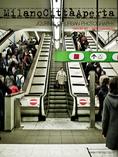events landscapes economics urban projects climate change premio tesi di laurea habitability culture premio letteratura urbanistica Community call for articles demography creativity simulation downtowns newsletter ecology information technology digitalization agriculture mobility Cohesion dottorati rural areas urban form
Issue #2 - WINTER/2010
from Milano Città Aperta
Milano Città Aperta | Journal of Urban Photography
Photography is a shadow projected on film of something we’ll never have a concrete, objective experience of, and of which we won’t even know the source of light, just like the prisoners in Plato’s cave, who will never know anything but the mere reflection of the outer world and of their own existence.
(Jean Baudrillard)
Since its birth, photography has had the extraordinary possibility of making visible something that, up to that point, was destined to remain invisible, hidden, or even unknown. Thanks to the revolution operated by the possibility of technically reproducing images, it was possible to document the entire world and thus modern age came to life. The essence of Photography, the representation of what’s real, is indissolubly connected to the notion of reality, just like the concept of light cannot exist without that of darkness, the image of a thing without the thing in itself, the visible without the invisible. The research of the unknown has always moved men along the path to knowledge and within this long haul Art (therefore Photography too) can help us take a few steps forward. And here we are to us.
The photos in this second number of MilanoCittàAperta explore, from different points of view, a common theme: invisibility.
The social invisibility of those minorities who still can’t enjoy many of those rights that we simply take for granted.
The financial invisibility of those who lost their jobs and, with them, the hope of building a future for themselves.
The housing invisibility of those who can’t afford to have a house of their own and are forced, for better and for worse, to earn some space wherever they can.
The physical invisibility of those workers who cross all the non-places between home and work every single morning and evening of their week.
The invisibility in space of those places unseen by the city’s sky, hidden within intricate, dark underground labyrinths.
The historical invisibility of ancient crafts dating from prehistorical times to today that seem to be more and more in danger of disappearing with the development of industrial civilization.
Enjoy your visit (of the invisible).
INDEX
• Shared living
by Daniele Pennati
Research based on different modes of shared living.
• A Prison under the sky
by Filippo Ceredi
Images of a family unjustly thrown out of their own caravan, funded by the local council, in Via Triboniano.
• Presence
by Thomas Pagani Roberto
Images of an underground world that stretches out beneath our city and within our conscience.
• Commuters
by Luca Napoli
A journey between the hinterland and the city that documents the physical spaces and the emotions in the life of a commuter.
• Working class
by Cristina Mian e Marco Frigerio
The industrial establishments disused due to delocalisation, inhabited by ghosts of those people that once worked there.
• Transhumance
by Marco Costa
A journey taken with shepherds, who, every year lead their flocks across the peripheries of the city to the Alps of Lombardy.
www.miciap.com




Planum
The Journal of Urbanism
ISSN 1723-0993
owned by
Istituto Nazionale di Urbanistica
published by
Planum Association
ISSN 1723-0993 | Registered at Court of Rome 4/12/2001, num. 514/2001
Web site realized by ChannelWeb & Planum Association | Powered by BEdita 3







